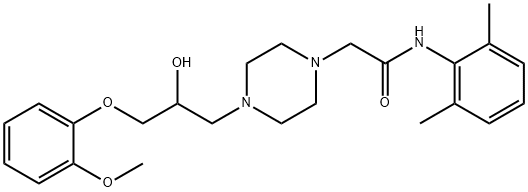Ranolazine

|
- ₹0
- Product name: Ranolazine
- CAS: 95635-55-5
- MF: C24H33N3O4
- MW: 427.54
- EINECS:620-450-7
- MDL Number:MFCD00864690
- Synonyms:1- 3-(2-Methoxyphenoxy)-2-hydroxypropyl -4- ...;1-Piperazineacetamide,N-(2,6-dimethylphenyl)-4-[2-hydroxy-3-(2-methoxyphenoxy)propyl]-;N-(2,6-dimethylphenyl)-2-[4-[2-hydroxy-3-(2-methoxyphenoxy)propyl]piperazin-1-yl]ethanamide;N-(2,6-diMethylphenyl)-2-{4-[(2R)-2-hydroxy-3-(2-Methoxyphenoxy)propyl]piperazin-1-yl}acetaMide;Ranolazine(Ranexa);100MG/500MG/1KG;Ranolazine N-(2,6-Dimethylphenyl)-2-[4-[2-hydroxy-3-(2-methoxyphenoxy)propyl]piperazin-1-yl]acetamide;Ranolazine (100 mg)
| Manufacturer | Product number | Product description | Packaging | Price | Updated | Buy |
|---|
Properties
Melting point :119-1200C
Boiling point :624.1±55.0 °C(Predicted)
Density :1.174±0.06 g/cm3(Predicted)
storage temp. :Sealed in dry,Room Temperature
solubility :DMSO (Slightly), Methanol (Slightly)
form :Solid
pka :14.06±0.20(Predicted)
color :White
CAS DataBase Reference :95635-55-5(CAS DataBase Reference)
Boiling point :624.1±55.0 °C(Predicted)
Density :1.174±0.06 g/cm3(Predicted)
storage temp. :Sealed in dry,Room Temperature
solubility :DMSO (Slightly), Methanol (Slightly)
form :Solid
pka :14.06±0.20(Predicted)
color :White
CAS DataBase Reference :95635-55-5(CAS DataBase Reference)
Safety Information
| Symbol(GHS): |

|
||||||||||||||
|---|---|---|---|---|---|---|---|---|---|---|---|---|---|---|---|
| Signal word: | Warning | ||||||||||||||
| Hazard statements: |
|
||||||||||||||
| Precautionary statements: |
|
Description
Ranolazine is an orally available, extended release drug for the treatment of chronic angina in patients who have failed to respond to prior angina therapy. Chronic stable angina (CSA) is a common symptom of coronary artery disease wherein plaques in the coronary vasculature restrict blood flow to the heart, which in turn leads to insufficient oxygenation of the heart, typically during physical exertion or emotional stress. A vast majority of the existing anti-anginal and anti-ischemic therapies aim to correct the imbalance between myocardial oxygen demand and supply through mechanisms that produce reductions in heart rate or blood pressure.Related product price
- 2-Cyanoacetamide
₹594-42422 - Propyl gallate
₹999-104645.28 - Thioacetamide
₹576-88537.68






